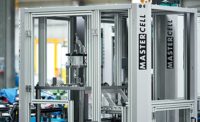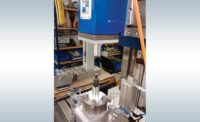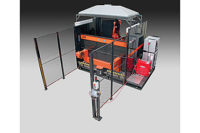Today’s printed circuit board assembly line is highly automated. Board loading, paste printing, pick-and-place, reflow, test and inspection—every process is covered by a standard machine, and assemblers have many brands to choose from.
However, when it comes time to integrate newly assembled boards into a final product, the enthusiasm for automation typically runs out. Why is that?
Stevan Dobrasevic, product marketing director at automation start-up Bright Machines Inc. in San Francisco, thinks he knows why. The traditional strategy for automating back-end processes is a hardware-first approach, he argues. The equipment is typically custom, expensive, and can take 12 months or more to implement, from the design phase to factory acceptance testing.
That sort of approach, he argues, is incompatible with today’s short product life cycles, consumer demand for customization, and business demand for faster return on investment (ROI).
“Let’s assume it costs $500,000 to automate three manual assembly stations at the end of a line,” he says. “If automating those three stations saves $120,000 in labor costs, then the payback time is over four years. For most businesses, anything over three years is too long.”
As a result, manufacturers have stuck with manual labor for back-end assembly tasks. But, while manual labor is certainly flexible, it’s not necessarily scalable, reliable or consistent. “Manual labor brings unpredictability into your process,” observes Dobrasevic.
Now, Bright Machines has developed an alternative to manual labor and traditional automation: software-driven “microfactories” designed to be flexible, modular and scalable. “Whereas traditional automation takes a hardware-first approach, we take a software-first approach. We set up our modules with software, we configure them with software, we run them with software, and we analyze and optimize their performance with software.”
Microfactories are created by combining one or more Bright Robotic Cells (BRCs) to form an automated assembly line. Two cell sizes are available, the BRC70 and BRC35, and they can be used together on the same line. Each BRC has a standard configuration that includes the chassis, electrical cabinet, robot, power supply and touch screen display.
The BRC70 has an internal volume of 70 cubic feet and can accommodate a maximum pallet size of 700 by 560 millimeters. It’s equipped with a Fanuc LR Mate 200iD/7L six-axis robot with a maximum payload of 7 kilograms. The BRC35 has an internal volume of 35 cubic feet and can accommodate a maximum pallet size of 700 by 450 millimeters. It’s equipped with a Nachi EZ03 four-axis SCARA robot with a maximum payload of 3 kilograms. Either cell can accommodate an assembly as tall as 250 millimeters and weighing up to 15 kilograms (including the pallet).
The cells are compatible with vibratory feeder bowls and other parts feeding equipment from outside suppliers. In addition, Bright Machines has developed a standardized tray feeder, the Tray Feeder 600, which fits neatly into the back side of the BRC70. The feeder can hold 25 trays. Each tray can hold up to 6 kilograms of parts, and trays can be swapped out in approximately 6 seconds.
Each cell has an embedded conveyor to pass pallets from cell to cell. Return conveyors bring pallets back to the start of the line. Elevators transport pallets vertically between the embedded conveyor and return conveyor. Extension conveyors can be placed in the line where needed to accommodate manual workstations or automated stations that don’t require a cell.
Robot end-effectors are available for various assembly tasks, such as placing boards into housings, inserting standoffs, assembling heat sinks, inserting through-hole components, and placing assemblies into packaging.
Equipment is also available for:
- Installing threaded fasteners, clips and washers.
- Welding, soldering and heat staking.
- Dispensing adhesives, sealants, grease and thermal paste.
- Press-fit assembly, such as installing bearings, connectors or DIMM cards.
- Printing and applying labels.
- Laser engraving.
Machine vision can be integrated for tasks such as inspection, sorting, bar code scanning, optical character recognition and robot guidance. Test equipment can be integrated for power-up testing, display testing and RF validation.
Any automation component, whether it is designed by Bright Machines or comes from a third party, can be quickly added to a cell using an open-framework device wizard to set up a driver for it in the system’s control software, Brightware. And, when it comes time to wind down production, the components can be repurposed to build the next product.
“Software-driven automation means that all these hardware modules are pre-integrated into the software,” says Dobrasevic. “Everything is plug-and-play.
“Within the software, you can quickly create production ‘recipes’ for a specific product. For example, you can program a conveyor to position a pallet for installing screws. These recipes are configured using graphical means, so they don’t require a whole lot of programming.”
With the software-first approach, engineers can have a system up and running in three to six months, says Dobrasevic.
Justifying Automation
To get an idea of how this might play out, consider a hypothetical scenario in which a company needs to assemble two products: A and B. Each product has a life cycle of two years.
Product A consists of a plastic housing, a plastic cover, a circuit board and five screws. The assembly process consists of the following steps: Place the housing onto a pallet. Insert the circuit board into the housing. Place the cover onto the housing. Secure the cover with five screws. And, finally, perform a functional test on the finished assembly.
Product B is similar, but the size and shape of the components are different, and it requires six screws instead of five. In addition, a bead of sealant is applied to the cover prior to assembly, and instead of a functional test, the finished product is placed into a tray.
The assembly line for Product A consists of four cells. At the front of the line, a worker at a kitting station places the parts onto a pallet. The pallet then goes to the first cell, where the circuit board is inserted. Next, the pallet moves to the second cell, where the cover is put on. At the third cell, the screws are installed. And, at the fourth cell, a robot moves the finished assemblies in and out of a functional test instrument. At the end of the line, the pallet is transferred by an elevator to a return conveyor, which brings it back to the front of the line.
To change over to assemble Product B, everything is reused except for the testing cell, which is removed and replaced with a dispensing cell.
“With software-driven automation, the work involved is minimal,” says Dobrasevic. “On the hardware side, we have to install a dispensing module for Product B. We need to exchange the grippers and the fixtures on the pallet, and we need to adjust the screwdriver. On the software side, we have to rework the recipe for Product B, but we can leverage the recipe for Product A, because it is similar.
“In terms of scheduling, it might take one to two months for delivery of the new hardware components, but the actual work of installing the new hardware might take five days, and reprogramming might also take five days.”
Application Examples
Bright Machines’ microfactories are already being used to assemble smart meters, networking equipment, building security systems, battery modules, automotive control units, medical devices and even a coffee maker.
Recently, a manufacturer of cordless tools began using a microfactory to assemble control units for the brushless DC motors that power its products. The control unit is simple enough—a circuit board inside a plastic frame—but it’s produced in multiple variants, depending on the tool.
Assembling the unit is a two-step process:
- dispense sealant onto the back of the board.
- weld the board onto the frame.
The manufacturer required four employees to perform these two steps at a rate of 437 units per hour. At that rate, the operation could produce 1.7 million power tools in a year. “Not bad, but with market projections topping $38 billion in sales by 2025, not quite big enough,” says Dobrasevic.
The company needed to automate. Bright Machines provided a Microfactory consisting of four robotic cells. At the first cell, a robot picks up a frame from a bulk feeder and loads it onto a pallet. At the second cell, a robot picks up a board from a tray, places it onto the pallet, and dispenses the sealant. At the third cell, the board is welded onto the frame. At the fourth, a robot loads the finished assembly into a tray. The empty pallet is transferred to the beginning of the line.
“This a fully automated line,” says Dobrasevic. “An operator is only required occasionally to replenish the frames and change out the tray feeders with the circuit boards or the finished assemblies.”
With the Microfactory, the manufacturer is producing 510 units per hour, equating to a 17 percent gain in throughput. The cost savings are also substantial. In one shift, the Microfactory produces control units at a cost of $0.16 per assembly, compared with $0.18 per assembly for the manual operation, an 11 percent savings.
That figure gets better with each shift. In a two-shift operation, the cost per unit drops to $0.08 per assembly. And, in a three-shift operation, it drops to $0.05 per assembly. “Ultimately, you can get a 72 percent lower cost per unit by using automation,” says Dobrasevic.
Automation as a Service
In addition to unique technology, Bright Machines also offers manufacturers a unique business model: automation as a service. Rather than purchase a Microfactory with a large, up-front capital investment, manufacturers can essentially rent the equipment, paying for it as if it were a service rather than machinery.
“Many manufacturers would like the benefits of automation, but their capital budgets have been reduced or frozen,” explains Dobrasevic. “The automation-as-a-service model avoids the problem of large up-front costs. Instead, you pay as you go. The first payment doesn’t occur until after production starts. That allows you to use an operating budget, instead of a capital expense budget.”
There are other benefits, too. “There is less financial risk and more flexibility,” asserts Dobrasevic. “You can scale up or down as volume requirements change. There’s also uptime insurance. With automation as a service, you are, in effect, purchasing uptime, so you have predictable output. You can also get up and running faster because purchasing is streamlined and contracts are simpler. And, you’re assured of always having the latest hardware and software on the shop floor. Your line becomes future-proof.”








